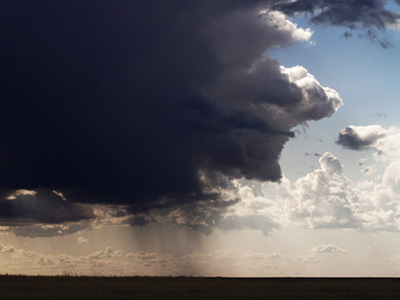The structure and function of grassland ecosystems across the Southwestern United States are influenced by major attributes, including climate and soils. Ecosystem structure refers to the spatial arrangement of the living and nonliving elements of an ecosystem, and ecosystem function refers to the processes where the living and nonliving elements of ecosystems change and interact (Finch et al. 2004).
Climate

William Pope / NPS
Precipitation regime is the most important climatic factor for determining the structure and function of southwestern ecosystems. The availability of moisture drives (or limits) basic ecological processes, such as primary production, nutrient cycling, and plant reproduction (Miller 2005). Precipitation events in arid and semi-arid southwestern grasslands and shrublands are spatially variable and punctuated by extended dry periods, creating systems with high potential for evapotranspiration and limited opportunities for soil-water recharge. Seasonality, area, intensity (amount of moisture per unit of time), and form (snow versus rain) of precipitation events strongly influence which plant species and communities dominate grassland and shrubland ecosystems (Miller 2005).
Summer monsoon precipitation is an important source of moisture for arid and semi-arid grasslands in the American Southwest. Moist air masses originating in the Gulfs of Mexico and California are believed to be the source of the Southwest monsoon, which extends north from central Mexico to portions of the southwestern and central United States. Summer monsoon storms are typically high-intensity convective storms of short duration. The intensity of a precipitation event, in combination with soil surface characteristics, determines how much infiltration will occur and how much moisture will be lost as runoff (Whitford 2002). Summer monsoons of short duration may trigger soil surface processes, but they may not be sufficient to initiate seed germination, photosynthesis, or soil-water recharge (Miller 2005). A larger proportion of precipitation is lost as surface water runoff during summer monsoon storms than during winter storms, when moisture from melting snow can penetrate to greater soil depths. In contrast to monsoon precipitation, winter storms are lower-intensity, of longer duration, and cover larger areas. Winter precipitation can recharge soil water and affect the growth of perennial, deeply-rooted plants.
A second important climatic factor—wind—affects the structure and function of grassland and shrubland ecosystems by influencing wildfire behavior and rates of evapotranspiration. Wind is also a major driver of erosion, redistributing surface soil and soil-forming materials (Whicker et al. 2002). Disturbances such as wildfire and livestock grazing can contribute to dramatically increased levels of wind erosion.
Soils
In addition to climate, soils are major determinants of grassland and shrubland ecosystem structure and function. The components of the soil—mineral nutrients, organic matter, water, and soil biota—regulate hydrologic processes and nutrient cycling (Miller 2005). In short, soils store and deliver the water and nutrients which sustain grassland and shrubland plant and animal populations. Soil development is slow in regions with arid and semi-arid climates. Low rates of weathering result in weakly-developed soils that closely resemble the rock from which they were derived. Nutrient turnover in dryland soils is surprisingly rapid, leading to little accumulation of nitrogen, phosphorus, and other plant nutrients (Schlesinger et al. 1990). Many species of arid and semi-arid grassland vegetation rely on symbiotic relationships with soil biota like fungi and bacteria to acquire nutrients and moisture in an environment where both are limited.
Prepared by Jamie Nielson, Kelly Reeves, and Lisa Thomas, Southern Colorado Plateau Network Inventory and Monitoring Program, 2010.
Part of a series of articles titled Grasslands of the American Southwest.
Last updated: July 30, 2015
